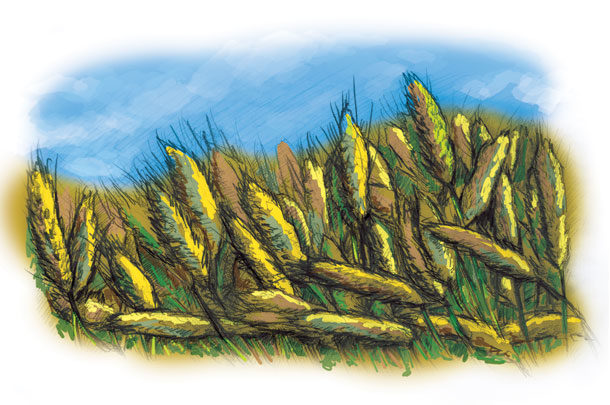Spring cereal forages are an important part of the total forage program. In the last few years, the industry has seen an increase in the use of these spring annuals. This is partly due to the reduced planting cost per acre compared to perennial crops. With the tight margins in the livestock markets, producers have been looking for lower-cost feed options simply due to reduced cash flow.
Spring annuals give a large amount of tonnage in a relatively short period of time, unlike perennial pastures or hay fields that may take a year to reach maximum production. They can be planted early and are often ready to be harvested between cuttings of alfalfa and grass, which can help spread labor throughout the year.
Which small grain to plant?
There are several small grains to choose from for spring planting, but the most common are barley, triticale and oats. I find people have strong opinions about which grain is best for them based largely on what has been historically popular in their area – but with the recent improvements in true forage-type varieties of small grains, the advantages of each species are not so cut and dried.
As you try to determine which small-grain option you should use, here are some things to consider:
- Oats may outyield triticale under good conditions in the North. In adverse conditions, the reverse may be true, while in the transition zone, triticale may outperform oats if summer heat hits early.
- Triticale is less competitive than oats, making it a good option as a nurse crop if the main concern is not to choke out the perennial crop.
- Oats, with their more aggressive establishment, may be a better nurse crop if weed pressure is a concern.
- Triticale can be higher-quality forage than oats, making it a better choice for feeding high-producing animals.
- Oats are often the least expensive to plant per acre.
- Barley often does better in drier conditions than oats.
- Barley forage quality is very high, and it will be ready to harvest at boot stage a week or more before triticale or oats, but the yield may be lower.
Plant straight grains or add a legume?
Once a decision is made on which grain to plant, the next question is often, “Should I plant peas with it?” From years of observation in the Midwest, we cannot always assume an increase in tonnage from adding a legume. Forage crude protein content is often improved by adding a legume, but in situations of high soil nitrogen levels, the protein content of the small grains by themselves is high enough already. In situations where the forage will go to soft dough stage, this additional legume protein can become much more important because the protein content in the small-grain forage decreases dramatically by percentage as the grain starts to develop.
The most common legume added to small grains is peas. Both winter peas and spring peas can work in spring planting situations, but generally spring peas grow faster and are better able to keep up with the small grains and contribute to the forage biomass.
The most recent thought to ponder when considering mixing a legume with your cereal forage is using an annual clover rather than peas. Some interesting work has been done recently with berseem and balansa clover mixed with small grains. Unlike peas, these annual clovers offer the chance of a second cutting, which will be almost pure legume. Therefore, these clovers can offer significant improvement on yield compared to using peas as the legume portion, but there are some tricks to making this work.
First, consider how you will plant. Mixing small-grain seeds with clover seeds in the same seedbox and planting the mix more than an inch deep is not going to work. The clovers need to be a half-inch deep or less, and the small grains like to be from a half-inch to an inch.
One creative approach has been to broadcast the clovers just in front of the grain drill. There is just enough disturbance by the grain drill to get seed-to-soil contact for the clovers. The second thing to do is to back off the seeding rate of the small grains but keep the clovers at the same rate as a full stand. This is different than a grain and pea mix, where the seeding rate of both components are scaled back.
An important point that is often overlooked is: While the benefit of legumes in the spring-planted forage crop is debatable, the addition of legumes to soils that are on the low side for nitrogen is a huge benefit that will positively impact that field for the next year and maybe even further into the future. In many cases, even if there is no tonnage benefit to mixing a legume with the cereal crop, it is still worthwhile in the long run.
Nurse cropping?
There is a great debate on the pros and cons of using nurse crops. The farther north one goes, the more common the practice. By using a nurse crop, the producer can increase his total forage yield in the seeding year and not have to work the field again to plant his perennial crop. The nurse crop can also help protect against damage from late-spring freezes and winds.
However, there is a chance of excessive competition from the nurse crop weakening the perennial crop for several years down the road. If you are short on forage now, the highest-yielding scenario is to plant a cereal crop alone at full rate and then plant a perennial crop following it in the late summer. Depending on your location, you might have time to grow another crop such as sorghum-sudan in between the spring grain and the late-summer perennial seeding.
If the decision is made to use a nurse crop, please note: The seeding rate of the nurse crop should be reduced by 50% compared to a straight seeding rate. This is especially true of wide-leaf forage-type triticales and oats. The reason this is necessary is to give the perennial grasses and/or alfalfa a chance to establish. Backing off the nurse crop seeding rate is a compromise that gets you a harvest soon after planting but also gives your perennial crop a chance to thrive in the long run. It is obvious then that a full rate of a cereal crop planted alone will give more tonnage than a reduced rate used as a nurse crop.
When to harvest?
It almost goes without saying that if you are planting grains for forage in the spring, you are in a hurry for some tonnage. But a few weeks’ difference in harvest time in early summer can have a huge impact on the success of your spring grain forage crop. As you travel from east to west across the country, the tendency is to let small-grain crops grow longer before harvest. In the East, most producers harvest small grains at flag leaf or before. In the West, small grains are often harvested at soft dough stage. Which way is correct?
The difference in harvest time between flag leaf and soft dough varies, but it is somewhere around 30 days. In those 30 days, total dry matter increases 50% or more, digestible fiber percentage plummets, crude protein drops, and starch increases due to grain formation. If you just need tons of feed to keep dry cows alive and you are not feeding any other starch source, soft dough might work. If you are feeding the high-milking group in a dairy herd and they are already getting high amounts of corn, more starch may not be what you need, but some digestible fiber can be almost magical.
A final consideration on when to harvest is what else could you grow in those 30 days from flag leaf to soft dough. High in the Rockies, you may not have time to grow anything else, whereas in the Midwest, you cannot get your corn planted on time going to soft dough.
Few crops are as flexible as small grains. When taken at boot stage, few crops accumulate dry matter per day more quickly. Taken just before flag leaf, it will be the highest-quality fiber you produce on the farm. Fast growth and several harvest opportunities based upon your yield and quality needs make them an important forage option for all of us to consider.










